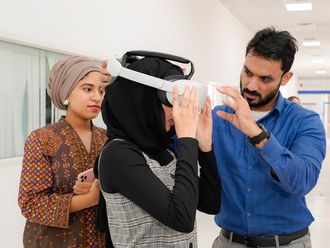_copy_resources1_16a0851e614_medium.jpg)
Dubai: You may think that by obsessively cleaning your house, you are keeping your child safe from germs and viruses. However, those very cleaning products could be playing a role in your child’s weight issues.
A study published in the Canadian Medical Association Journal suggests that exposure to disinfectants and multi-surface cleaners used at home could be making children overweight by altering their gut microbiota.
The study analysed the gut flora of 757 infants from the general population at age 3-4 months and weight at ages 1 and 3 years, looking at exposure to common cleaning products. It found that altered gut flora in babies 3-4 months old showed lower levels of Haemophilus and Clostridium bacteria but higher levels of Lachnospiraceae. However, the same association with detergents or eco-friendly cleaners was not found.
On the other hand, babies living in households that used eco-friendly cleaners had different microbiota and were less likely to be overweight as toddlers, the study found.
_resources1_16a0851e5f5_original-ratio.jpg)
The data that Canadian researchers used was from the Canadian Healthy Infant Longitudinal Development (CHILD) birth cohort and the findings were compared to the World Health Organisation growth charts for body mass index (BMI) scores.
While this study, as well as other similar ones, call for further investigation in the matter, researchers conclude that using eco-friendly products can lead to a generally healthier overall lifestyle, for all, not just for children.
Even though there is no conclusive evidence, the fact of the report even raising these concerns is a concern. We speak to experts in the UAE to gauge how such reports should be viewed.
What are gut microbiota?
Dr Sridhar Kalyanasundaram, Consultant Neonatologist, Head of Department, Zulekha Hospital, Dubai, says, “We are born with no bacteria in our body; however, this changes within the first few hours to days when our body starts getting colonised with a plethora of bacteria, many of which set up a long-term symbiotic relationship with us. We have more bacteria than the number of cells in our body, and ranges up to 1,014 organisms in our gut. We also have resident flora on our skin, mouth, airways, etc. This is our microbiota, and this changes depending on various factors such as (in babies) the mode of delivery and breast feeding (vaginal delivery and breast feeding give us healthy flora compared to formula feeding and delivery by LSCS (Lower Section Caesarean Section), genetics, the environment we live in, antibiotic use, etc.
The environment we live in affects the gut flora — and living in a very clean, disinfected environment creates a selection bias in terms of the variety of organisms that stay in our system.”
“In addition, gut microbiota helps in resisting pathogenic bacteria getting a foothold, thus reducing the risk of infection,” says Dr Kalyanasundaram.
Dr Revathi Srinivasan, Specialist Paediatrician, Aster Clinic, Al Nahda, Dubai, says, “Children are essentially born without microbes in their gut, and they are immediately colonised upon birth. Healthier maternal lifestyles and eating habits contribute to healthy gut microbes in the baby up to 9 months of life. On this foundation, the introduction of family foods is the main driver of development of the complex microbial ecosystem in the gut after 9 months. By the age of three, an individual’s gut microbiota gets established and is the same as that in an adult.”
What’s the role of gut bacteria?
“The gut microbiota has a role in many of our regular functions — [building] appetite, extent to which our foods are digested/absorbed, satiety (all of these affect obesity risk), bowel movement (normal vs constipation),” says Dr Kalyanasundaram. “[Gut microbiota] even impacts our mood and personality.”
What’s the relationship between household cleaners and gut bacteria?
“The gut microbial composition is mostly acquired from the environment that we live in — if we live in an environment that is continuously cleaned with anti-bacterial cleaners then the gut microbial composition will definitely be altered,” Dr Badi Alatasi, Consultant Paediatrician at Valiant Clinic Dubai told Gulf News.
There are many studies that link obesity with a loss of bacterial diversity in our gut. Experts have called for future studies that need to focus more on how the composition of gut bacteria can be altered to reduce the risk of obesity and given that the environment we live in and the lifestyles we choose can impact our gut microbiota, and hence, our health, there is cause to hope for more detailed data.
757
children who were 3-4 months and 1-3 years old were part of the study on the link between household disinfectants and obesityDr Kalyanasundaram says, “The environment we live in affects the gut flora — and living in a very clean, disinfected environment creates a selection bias in terms of the variety of organisms that stay in our system. Excessive antibiotic use, for example, changes the gut flora on a short-term basis. Cleaning chemicals affect the bacteria in our environment. This reduces the load [of bacteria], as well as creates a shift in pattern to certain groups of bacteria which may resist the disinfectant effect more. As our gut bacteria have a role in so many of our functions, some of these changes might impact on our health.
“We could show a preference for eco friendly products for various reasons, and this [study] could be one such reason,” Dr Kalyanasundaram added.
According to Dr Srinivasan, “The basic argument is that we’ve become too obsessed with cleaning agents and sterilisation. But exposure to potentially deadly infection isn’t a fun, carefree experience you can shrug off. We need to be clean, we need to use cleaning agents, but of course, judiciously.”
The issue here then is that can the excessive use of household cleaners, that often destroy bacteria, both good and bad, lead to a change in the composition of gut flora of babies that can actually impact their health? This is a concern that needs more research to be able to provide conclusive evidence.
Should such studies worry us?
On this particular study, Dr Kalyanasundaram says, “The Canadian study did not show a conclusive link between disinfectant use and obesity, but did show a pattern of predominance of a particular group of bacteria (Lachnospiraceae) associated with higher BMI. There are many factors which could have affected the study results — the authors [of the study] confirm that the rate of vaginal delivery/breast feeding vs Caesarean delivery/formula feeding was different between the groups. It is well known that both these factors have a clear impact on our gut bacterial pattern as well as risk of obesity and so, it is hard to attribute the effect to the use of disinfectants alone. It is important to consider all these factors, and not rush to conclusions.”
How clean is clean? Where should we draw the line?
Dr Alatasi highlighted that excessive cleaning can increase the chances of developing allergies.
“Our systems need to be challenged with bacteria to stop them from developing allergies,” he said. “I would not recommend the regular use of antibacterial cleaning products for that reason — despite there being no confirmed evidence that obesity in children is caused by using such cleaning products,” said Dr Alatasi.
There are places that require regular use of antibacterial cleaning agents such as hospitals and clinics where a high traffic of sick people exists along with an increased chance of communicable diseases but households are not in this category, said Dr Alatasi.
“In our households, we need to be clean but not sterile,” he said.
According to Dr Kalyanasundaram, “The hygiene hypothesis addresses the fact that children reared in relatively germ-free, protected environments have a higher risk of allergic diseases like asthma, allergic rhinitis,., etc compared to children brought up in environments with lot of exposure to soil organisms, animals and relatively earthy surroundings.
“In simplistic terms, if our immune system does not get adequate opportunity to fight infections, it simply ... increases the risk of developing allergy, etc. The same applies to kids who play more outdoors (getting dirty) with no restrictions compared to those confined to indoor play. Parents would do well to remember that teaching clean habits doesn’t mean depriving the child of normal outdoor play. It would help not to be obsessed with cleanliness but develop a balanced approach to allow normal play, exposure to soil, etc, at the same time ensuring the child washes hands before eating and cleans up after.They could also focus on using normal soaps/hand soaps/cleansers etc rather than antibacterial [products].”
Where does extra caution work?
“At home and in public places, including parks, restaurants, malls, while travelling etc,” says Dr Kalyanasundaram. “Most organisms that cause disease spread from close contact with people who have the infection or are carrying the organism (disease carrier as well as during the incubation period). When we are at home, and no one has an active infection, we can be fairly relaxed (especially when we know our cleaning routine ensures a reasonable degree of cleanliness).”
How can children develop strong immunity?
“Improving education/affluence and city living all lead to a situation where parents focus on infection prevention/hygiene, etc. There is also pressure from advertising which projects dirt as ‘dangerous’,” says Dr Kalyanasundaram. “Compared to how we lived as children, these days, children are part of the ‘overprotective attitude’ of parents, which is the norm except maybe in non-urban areas and in large families. We are seeing an increase in allergic diseases in the past 20 years or so, mainly related to similar factors.”












